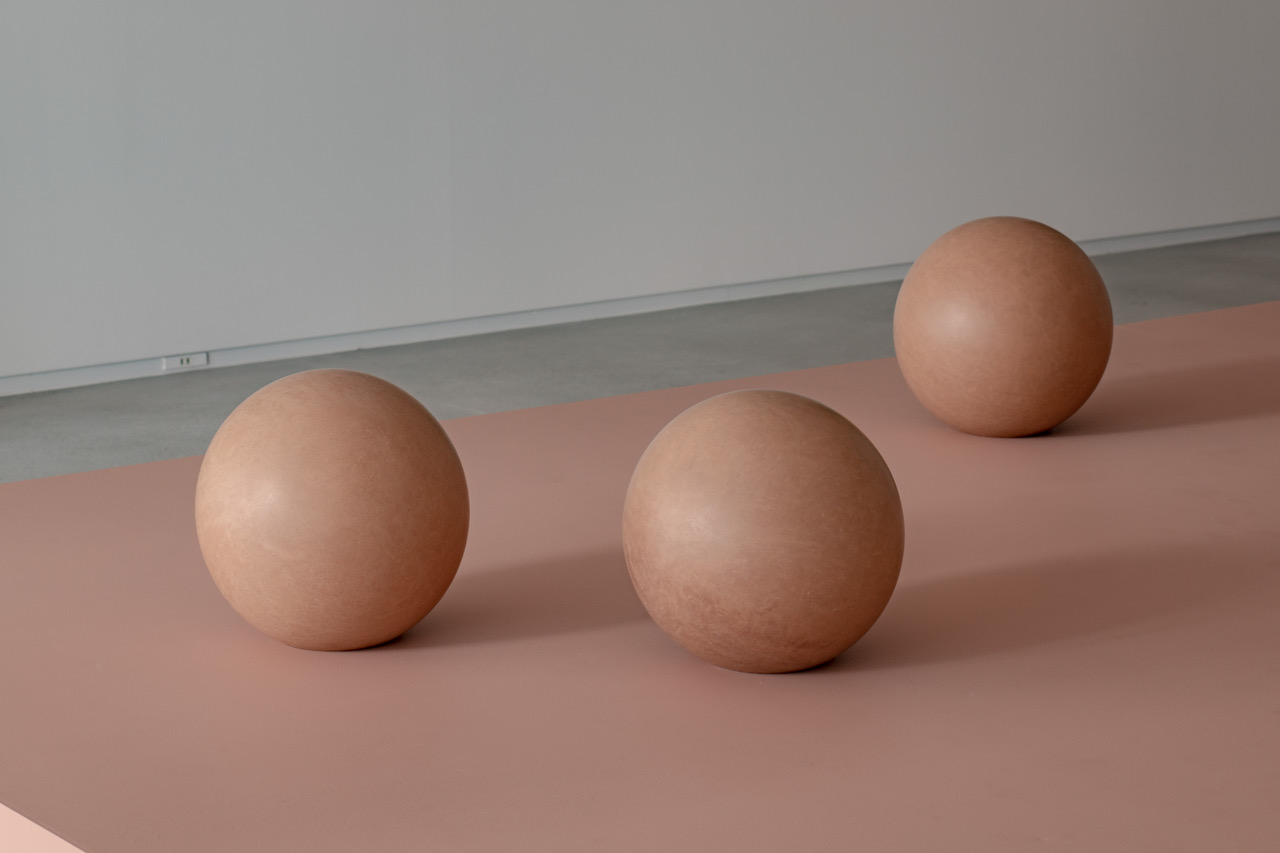Curator, director of Shiseido Gallery. Recently curated exhibitions include “Tsubaki-kai 8: This New World” (2021), “Surface and Custom,” “Yu Araki: Le Souvenir Du Japon” (2019), “Shuta Hasunuma: ~ ing” (2018), “Kami: Cosmic Wonder with Kogei Punks” (2017), and “Tsubaki-kai 2017: Shoshin – Genpei Akasegawa, Naoya Hatakeyama, Rei Naito, Zon Ito, Ryoko Aoki, and Yasutake Shimaji” (2013-2017).
Hirofumi Isoya, Activation, H 25×W 25×D 25cm, Ancient earthenware fragments from 3500-2500 BCE, clay Photo by Nobutada Omote, Courtesy of SCAI THE BATHHOUSE
“Go, go, go, said the bird: humankind cannot bear very much reality,” a retrospective exhibition of works by Hirofumi Isoya, was shown from September 9 to October 16 at SCAI PIRAMIDE, a special SCAI exhibition space that just opened last June in Roppongi. The exhibition encompassed a variety of works in formats including photography, sculpture and installation, which together made up a media space with almost architectural qualities.
Isoya’s artistic background includes studying architecture at university. It was his interest in a curriculum pursuing the “total art” of Bauhaus, that had inspired him to study architecture. His eventual studies at university involved familiarizing with multifarious presentation formats ranging from design plans and drawings to models and movies, all of which ultimately informed the artistic style of his current work.
Displayed on the wall of the main exhibition space was a series of works incorporating photographs that Isoya has been working on for about ten years, depicting phenomena that caught the artist’s attention within everyday life, and sceneries that involve slight creative modifications. In the process of selecting the photographs to be featured in this series, the artist converted the respective images into sepia, and put them into frames painted in one or two colors that were standing out in the original pictures. In other words, by first creating frames as sculptural objects of sorts, and subsequently adding photographs, Isoya reversed the usual process of framing photographs. When looking at the results, we are thus forced to reconfigure the colors and shapes in these images, and reconsider our interpretation of two- and three-dimensional elements. In some large works installed at various places on the floor, frames were propped against the wall, with sheets of needle felt sandwiched between the frames, floor and walls, and felt coming loose on the backsides of the frames. Felt was used here to enhance the works’ three-dimensional effect, and at the same time, to direct the viewer’s attention to the areas around and behind the frames. It is also a reference and homage to artists who pioneered the use of felt, such as Joseph Beuys and Robert Morris.
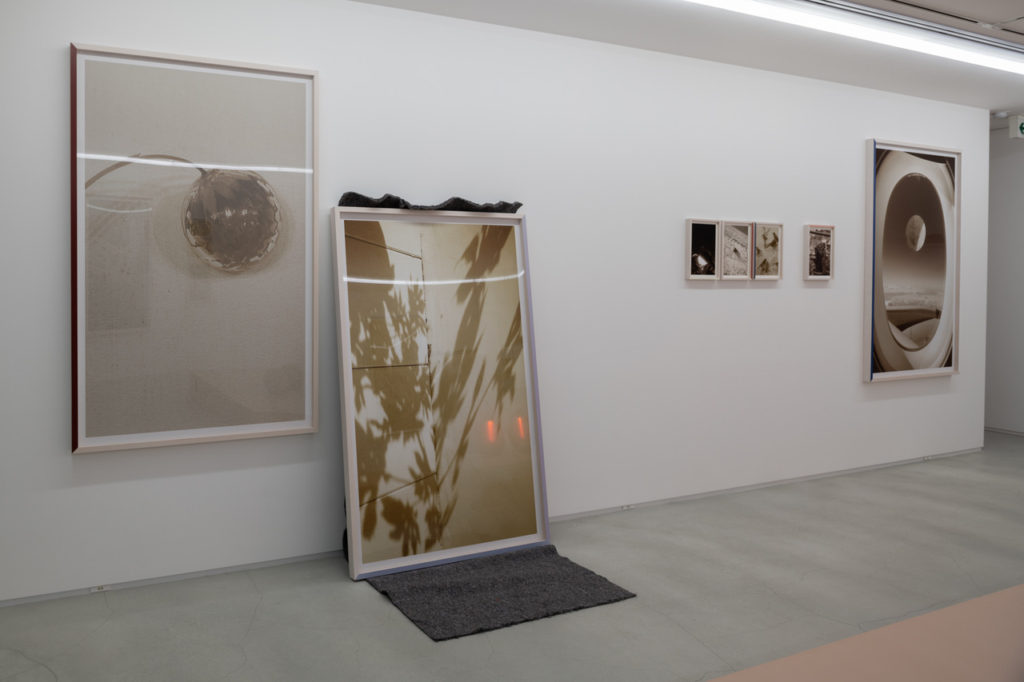
Installation view of “Go, go, go, said the bird: humankind cannot bear very much reality” (2021) by Hirofumi Isoya at SCAI PIRAMIDE, Tokyo. Photo by Nobutada Omote. Courtesy of SCAI THE BATHHOUSE
“Activation” (2021) is a spherical object made from a material for which the artist mixed in equal parts present-day pottery clay and mud, for which he crushed fragments of approximately 5,000-year-old Jomon ware that he had collected. This particular ceramic art is created by using contemporary means to stir times and cultures of the past, including breaking bits of ancient culture in the form of Jomon ware. Nevertheless, the modern clay is something that was dug up out of layers of earth as well. It seems as though two different eras and their respective times were contained within the hollow spherical body, whereas its egg-like shape suggests that something may eventually hatch from it.
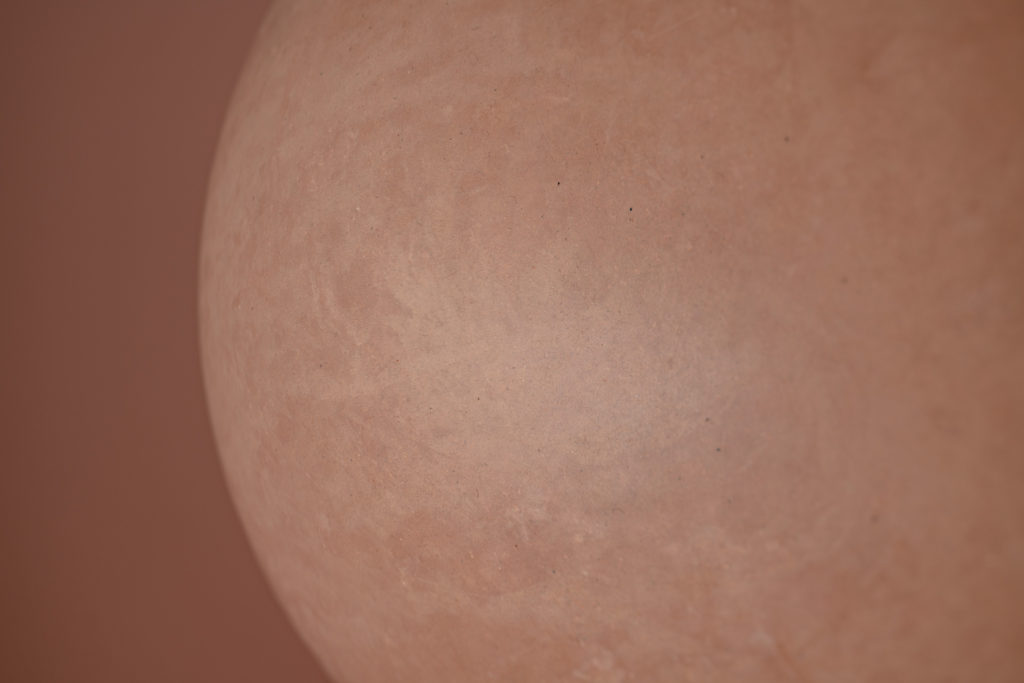
Hirofumi Isoya, Activation, H 25×W 25×D 25cm, Ancient earthenware fragments from 3500-2500 BCE, clay Photo by Nobutada Omote, Courtesy of SCAI THE BATHHOUSE
“Flowers and Bees, Translucent Archive” (2018), a work that emits a faint light, represents the artist’s attempt to visualize the material’s inherent aspect of time. He filled glass bottles with honey, into which he dipped fishing lamps as used for night fishing. The fact that the history of honey is said to be as old as the history of mankind itself, hints at the central position that honey has been occupying in human life since ancient times. Humans collecting honey have been depicted in mural paintings as old as 8,000 years. Honey has been used as an elixir of life, and honey bees have been adorning the crests of royal families. This is how humans have always sensed mystery and power in the effects of honey, and in the work of bees. Here the light filtered through the honey is a warm, amber-colored light that makes the viewer feel as if time flows in slow-motion. Just like bees gather around the light, and fish gather around the fishing lamp, in this case it is humans that are attracted to gather around the artwork.
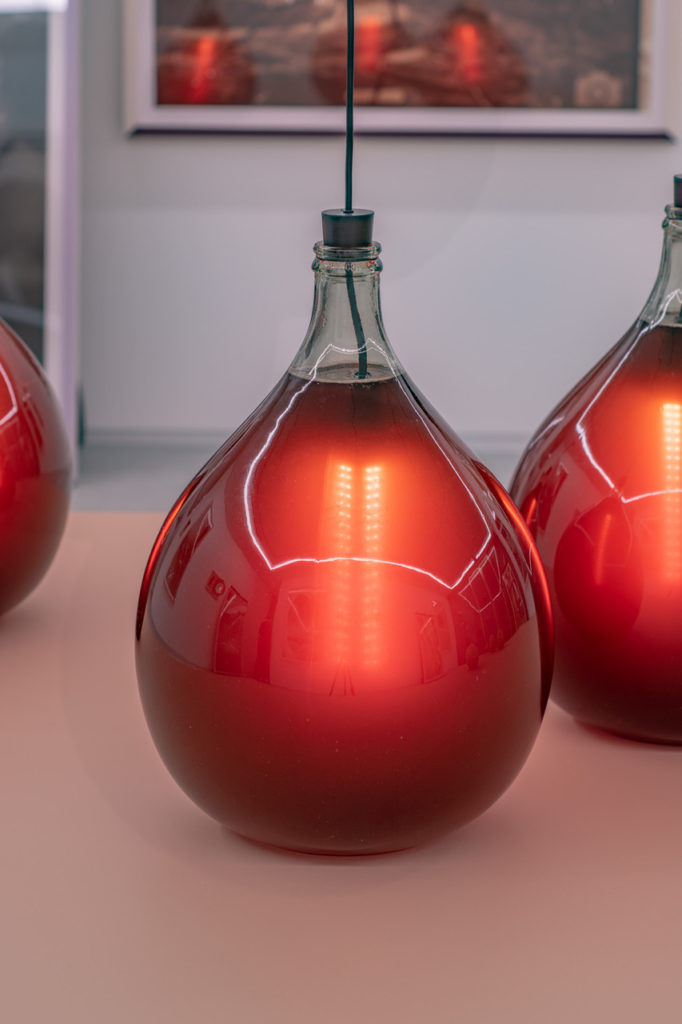
Hirofumi Isoya, Flowers and Bees, Translucent Archive, H 54×W 36×D 36cm, Honey, fishing light, glass bottle Photo by Nobutada Omote, Courtesy of SCAI THE BATHHOUSE
In the center of the exhibition space was a 30cm-tall pedestal, with traffic lines running around it. Arranged on the pedestal were three pieces each[1] of “Activation” and “Flowers and Bees,” about which Isoya explains, “The idea behind this number was to make the viewer aware of the things that both of these works have in common – things like taking organic matter and other things dissolving in the respective material, and incorporating them in timeless geometrical shapes.” Using three items each was at once a way to convey the materials’ density, and allow the visitor to examine the relationships between them from different angles. The light brown color of the pedestals emphasized the works’ organic texture, while also harmonizing with the colors of the sepia photographs and the frames around them.
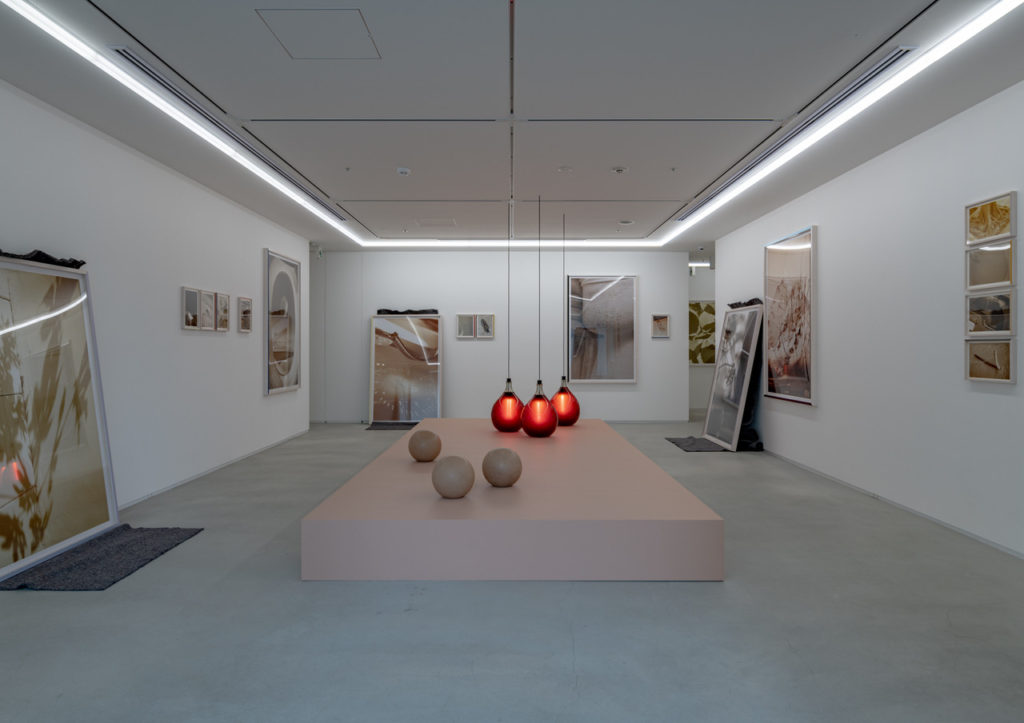
Installation view of “Go, go, go, said the bird: humankind cannot bear very much reality” (2021) by Hirofumi Isoya at SCAI PIRAMIDE, Tokyo. Photo by Nobutada Omote. Courtesy of SCAI THE BATHHOUSE
In the back of the exhibition space, “Palilalia and Heat” (2021) was mounted like a corner piece near the ceiling. An LED lamp for use at construction sites served as a light source, surrounded by red light and seemingly emitting heat, while a chain connected to the LED lamp was supposed to represent insects that gather around the light. The work was based on “Palilalia” that Isoya had made in 2013. In the original piece, the chain was used to visualize the trajectory of flying insects, and had insect specimen attached to it. It is said that insects keep flying around electric lamps because they mistake them for the moonlight, and this involuntarily repeated action is what the title “Palilalia” refers to. In the new work, the chain is coated with beeswax that contains scales of moths. This is how insects are part of the work yet in an invisible manner. As we humans have been pushing forward in the belief that economic growth is the only solution, we now have no other choice but to live with the invisible threats of things like radiation or viruses. Insects, have existed on Earth long before humankind, so how did they manage to overcome crises and survive? From its place in the corner, this work spreads its background and underlying idea across the room.
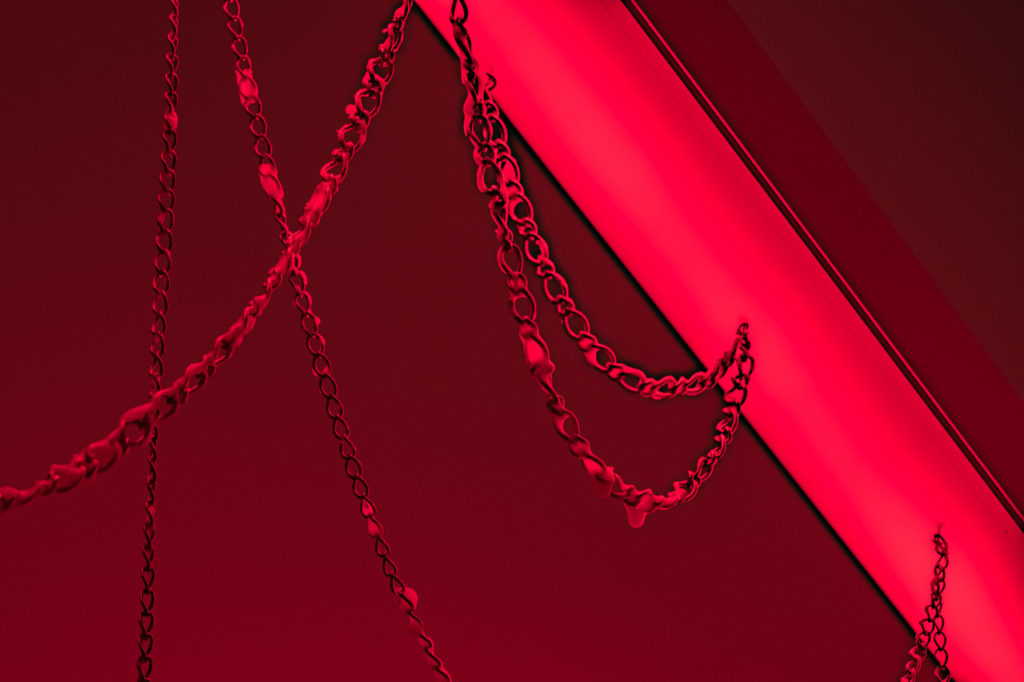
Hirofumi Isoya, Palilalia and Heat, 2021, H 54×W 82.5×D 5cm, LED light, chains, refined beeswax, moth scales Photo by Nobutada Omote, Courtesy of SCAI THE BATHHOUSE
The title of this exhibition is a quote from T.S. Eliot’s “time” themed poem “Burnt Norton.” In an uncertain world, people demand simple solutions. However, the world is diverse and complex, and there is never something like one simple solution. The quote is about a bird that encourages humans in pursuit of the truth and a convincing solution, to keep thinking rather than offer answers. Eliot’s poem also includes the following line. “What might have been is an abstraction. Remaining a perpetual possibility. Only in a world of speculation.”[2] According to Isoya, ”offering choices in the pursuit of ‘one simple solution’ is one thing that art can do,” and while juxtaposing his own view with Eliot’s, he charged the exhibition with an abstract quality that is open to free thoughts and ideas. The fact that the viewers can connect the exhibits to their own memories and experiences, introduce their own individual views, and imagine “what might have been,” will certainly elicit a broad variety of options.
[1] For displays of “Activation” and “Flowers and Bees,” the number of pieces of each work varies by exhibition.
[2] From T.S. Eliot, Four Quartets
Translated by Andreas Stuhlmann
INFORMATION
Hirofumi Isoya
"Go, go, go, said the bird: humankind cannot bear very much reality"
Date: 2021.9.9 - 10.16
Venue: SCAI PIRAMIDE


